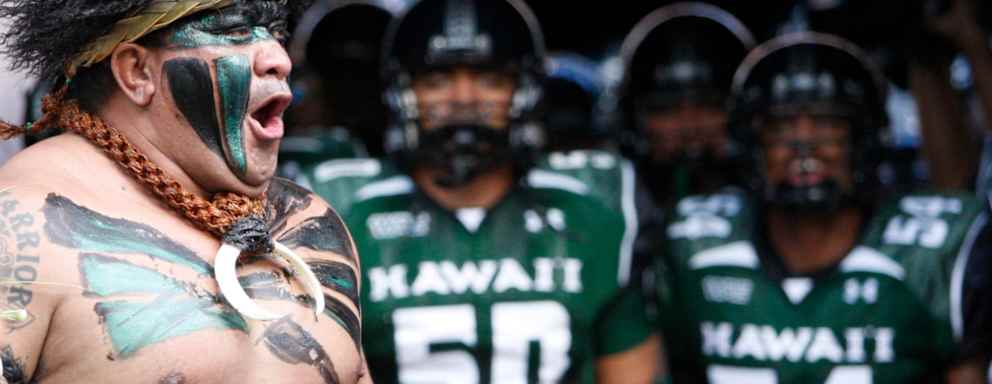The Movement Against Racist College Mascots Continues
 Credit: Kent Nishimura / Stringer / Getty Images Sport / Getty Images
Credit: Kent Nishimura / Stringer / Getty Images Sport / Getty Images- Public pressure has prompted many colleges to revise or eliminate racist symbols and imagery from college athletics.
- Some U.S. colleges still use Native American and Confederate images in their mascots and branding.
- The fraught history of Warriors and Rebels is still being written.
The University of Nebraska Lincoln (UNL) has updated its mascot, the latest in a long line of revisions to controversial or racist mascots in U.S. college athletics.
UNL, located in the American Corn Belt, has featured Herbie Husker as its mascot since the mid-1970s. A cartoon farmer, Herbie long flashed the “OK” hand gesture — thumb and forefinger pinched together, last three fingers splayed.
Concerned that the gesture is now considered a hate symbol (signaling the letters “W” and “P” to stand for for “white power”), UNL has updated Herbie to hold up just a forefinger: “We’re No. 1.”
In 2020, a slew of consumer brands — Aunt Jemima, Mrs. Butterworth’s, and Uncle Ben’s included — replaced product imagery deemed racist. Moreover, Washington, D.C.’s NFL team became the Washington Commanders, changing its team name from a slur against Native Americans.
At the college sports level, similar changes took place. Florida State University disavowed the “Gator Bait” chant, which called on “horrific historic racist imagery” of Black people as alligator bait. Well before 2020’s anti-racist movements, however, many colleges had already replaced controversial mascots.
Colleges Were Forerunners in Replacing Racist Mascots
Since the late 1960s, the National Congress of American Indians has called for the end of Native American stereotypes in sports, media, and pop culture.
In the early ’70s, Stanford University and Dartmouth College were among the first to make the change. Stanford renamed its sports teams to “the Cardinals,” adopting the Stanford Tree as its mascot. Dartmouth’s sports teams assumed the nickname “Big Green.”
Concern over mascots being racist arose again in the 1990s. In Wisconsin, Marquette University‘s mascot shifted from “Willie Wampum” to “First Warrior,” finally landing on the “Golden Eagles.” In Mississippi, Alcorn State University gradually relinquished the name “Scalping Braves.”
In 2005, the National Collegiate Athletic Association (NCAA) set out to eliminate “hostile and abusive racial/ethnic/national origin mascots” and team names. The NCAA distributed a “self evaluation” to 33 colleges. Those found guilty of employing inappropriate mascots would be banned from using the imagery during post-season play and prohibited from hosting tournaments.
The Impact of Race-Based Mascots on Campus and Beyond
Over the years, Native American and Confederate mascots have drawn the most ire. Studies show the Native American mascots cause mental harm to Indigenous people, particularly students. Such mascots decrease self-worth and community worth. They can also perpetuate negative stereotypes of Native Americans and other minoritized racial groups.
Many tribal leaders believe Native American mascots create hostile environments and are disrespectful and misappropriate their cultures. In some cases, however, Native American schools use these mascots, and some tribes have supported colleges retaining their Native American iconography.
Native American mascots are common among high schools. “Warriors” and “Indians” remain among the top 10 high school mascots. Over 1,000 high schools still sport Native American team names. Of these, 23 Native American mascots are used by tribal high schools affiliated with the Bureau of Indian Education.
When the NCAA came down on colleges with Native American mascots, the association said tribes’ approval was the main factor in mascot use. College mascots that gained support from local tribes include the Central Michigan University Chippewas, the Florida State University Seminoles, and the Mississippi College Choctaws.
Attorney John B. Rhode argued in the mid-’90s that “Many mascots are truly intended to honor, and in the eyes of many, they do honor. A name that honors need not and ought not be changed.”
Rhode pointed to Timm Williams, a politically active Yurok Indian who performed as Stanford’s now-disavowed “Indian” mascot, Prince Lightfoot, at games in the ’60s.
A survey by Quality Logo Products found that the University of Notre Dame’s Fighting Irish leprechaun was among the most offensive mascots in college sports. However, the Ancient Order of Hibernians, the oldest and biggest Irish-Catholic Organization in the United States, met the news with “disbelief and despondency,” calling the findings a “media-manufactured controversy.” Quality Logo Products then took down its survey results.
Old Mascots Die Hard
Only four states — California, Maine, Oregon, and Wisconsin —have laws or Department of Education policies that bar public schools from using Native American mascots. Even so, social pressure is often enough.
Meanwhile, Tennessee law holds that the state has no authority “to require or to prohibit or impair” any institution from using the mascot of its choice.
Once forced to change their mascots, schools and sports teams often have a hard time rebranding. During its rebranding, the Washington, D.C., NFL team played two seasons as the Washington Football Team before arriving at the Commanders.
At the college level, Iowa’s Simpson College spent 17 years without a mascot after removing a slur against Native Americans from its brand. The liberal arts college recently settled on “Thunder the Elephant.”
Likewise, after ridding itself of its “Gaucho” mascot — an “angry, racist caricature” of a South American cowboy — California’s Saddleback College is asking for public input on a new symbol.
Old mascots are not easy to forget, either. According to Michael Kraus of the Yale University School of Medicine, “If you say we’re not using the mascot, but students around campus can easily find it, can easily wear it, and there are no sanctions for doing that, the mascot can take on a life of its own and become an image of something else.”